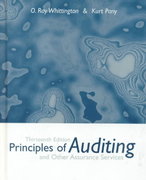Select the best answer for each of the following. Explain the reasons for your selection. a. In
Question:
Select the best answer for each of the following. Explain the reasons for your selection.
a. In planning and performing an audit, auditors are concerned about risk factors for two distinct types of fraud, fraudulent financial reporting and misappropriation of assets. Which of the following is a risk factor for misappropriation of assets?
(1) Generous performance-based compensation systems.
(2) Management preoccupation with increased financial performance.
(3) An unreliable accounting system.
(4) Strained relationships between management and the auditors.
b. The audit committee of a company should normally be made up of:
(1) Representatives from the client's management, investors, suppliers, and customers.
(2) The audit partner, the chief financial officer, the legal counsel, and at least one outsider.
(3) Representatives of the major equity interests, such as preferred and common stockholders.
(4) Members of the board of directors who are not officers or employees.
c. Which of the following should not normally be included in the engagement letter for an audit?
(1) A description of the responsibilities of client personnel to provide assistance.
(2) An indication of the amount of the audit fee.
(3) A description of the limitations of an audit.
(4) A listing of the client's branch offices selected for testing.
d. Which portion of an audit may not be completed before the balance sheet date?
(1) Tests of controls.
(2) Issuance of a management letter.
(3) Substantive testing.
(4) Assessment of control risk.
e. Which of the following should the auditors obtain from the predecessor auditors before accepting an audit engagement?
(1) Analysis of balance sheet accounts.
(2) Analysis of income statement accounts.
(3) All matters of continuing accounting significance.
(4) Facts that might bear on the integrity of management.
f. As one step in testing sales transactions, a CPA traces a random sample of sales journal entries to debits in the accounts receivable subsidiary ledger. This test provides evidence as to whether:
(1) Each recorded sale represents a bona fide transaction.
(2) All sales have been recorded in the sales journal.
(3) All debit entries in the accounts receivable subsidiary ledger are properly supported by sales journal entries.
(4) Recorded sales have been properly posted to customer accounts.
Step by Step Answer:

Principles Of Auditing And Other Assurance Services
ISBN: 9780072327267
13th Edition
Authors: Ray Whittington, Kurt Pany





